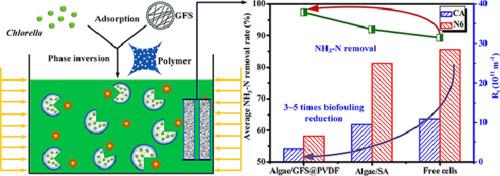Water Research ( IF 12.8 ) Pub Date : 2020-09-23 , DOI: 10.1016/j.watres.2020.116430 Lei Qin , Mingzhen Gao , Mengyuan Zhang , Lihua Feng , Qiuhua Liu , Guoliang Zhang

|
Low microbial activity and serious membrane biofouling are still critical problems that hinder the extensive application of membrane bioreactor (MBR) for industrial wastewater treatment. To address these bottlenecks, we report a new specialized microorganism encapsulation strategy for constructing a highly efficient MBR system. In our study, the algae-entrapping fiber macrospheres with polymeric coating were first coupled with membrane separation for treating refractory high-ammonia nitrogen wastewater. In comparison with traditional alginate beads, the developed macrocapsule (~0.5 cm) exhibited higher biomass harvesting and lower microbial leakage because of the confined micro-aerobic environment created by dual encapsulation of rigid inorganic macrosphere and porous polymeric layers. Application of algae-encapsulating macrocapsule to MBR presented excellent chemical oxygen demand (COD) and ammonia nitrogen (NH3-N) removal efficiency of 62.23 and 97.38 %, respectively, which were higher than the corresponding values for algae/SA beads and free algae. The biodegradation performance of NH3-N by encapsulated microalgae was similar or superior to that by free cells when the initial content of ammonia nitrogen ranged from 50 to 100 mg/L. The results well demonstrated that the GFS@polymer macrocapsule as a physical barrier reduced the inhibitory effect of higher concentration ammonia nitrogen on the bioactivity of living cells. Importantly, the encapsulated core-shell macrocapsules showed superior anti-biofouling capacity, which had a membrane resistance of 3-5 times lower than that of cell/alginate beads and free cells. This work will open a new avenue to develop a novel encapsulated MBR for various non-degradable wastewater treatments as an energy-saving and sustainable way.
中文翻译:

包囊藻类在MBR中的应用,用于高氨氮废水处理和生物污染控制
微生物活性低和严重的膜生物污染仍然是严重的问题,阻碍了膜生物反应器(MBR)在工业废水处理中的广泛应用。为了解决这些瓶颈,我们报告了一种用于构建高效MBR系统的新型专门微生物封装策略。在我们的研究中,首先将带有聚合物涂层的藻类捕集纤维大球与膜分离相结合,以处理难处理的高氨氮废水。与传统的藻酸盐珠相比,发达的大胶囊(〜0.5 cm)表现出更高的生物量收获和更低的微生物泄漏,这是由于刚性无机大球体和多孔聚合物层的双重封装产生了密闭的有氧环境。3- N)的去除效率分别为62.23%和97.38%,高于藻/ SA珠和游离藻的相应值。NH 3的生物降解性能当氨氮的初始含量在50至100 mg / L范围内时,包囊的微藻产生的-N与游离细胞相似或更好。结果很好地证明了作为物理屏障的GFS @聚合物大胶囊降低了高浓度氨氮对活细胞生物活性的抑制作用。重要的是,包封的核-壳大胶囊显示出优异的抗生物结垢能力,其膜抗性比细胞/藻酸盐珠和游离细胞的膜抗性低3-5倍。这项工作将为开发一种用于各种不可降解废水处理的新型封装MBR开辟新途径,以此作为一种节能和可持续的方式。



























 京公网安备 11010802027423号
京公网安备 11010802027423号